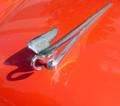|
Re: Re-installing rear brake drums
|
||||
|---|---|---|---|---|
|
Webmaster
|
Curious if you have measured the gap between the edge of the drum and the edge of the backing plate when mounted and compare that to the other side. That should show if the drum in question is sitting more inboard that the other side.
Not how the axle shim stack affects that relationship.
Posted on: 2023/7/27 7:48
|
|||
|
-BigKev
1954 Packard Clipper Deluxe Touring Sedan -> Registry | Project Blog 1937 Packard 115-C Convertible Coupe -> Registry | Project Blog |
||||
|
||||
|
Re: Re-installing rear brake drums
|
||||
|---|---|---|---|---|
|
Home away from home

|
Thanks to all that have thus far offered both your expertise and your insights.
Since hitting something was mentioned in David's post, I'll say that while I've not run into anything with the car, I do live in northeast Ohio where finding a smooth road is often a challenge and bent suspensions are pretty common. That said, a straight edge confirmed my suspicions that the backing plates were not damaged. Nevertheless, the thought of something being "tweaked" has stuck with me and, thinking back to Ross' suggestion to look for a twist in the shoe, I took a closer look at the pair on my car. As I mentioned earlier, I took some measurements and found that the friction material was worn no more than 1/32" at its worst spot and a visual inspection confirmed that there was no twist in the shoe frame. However, the measurements did indicate a wear pattern from side to side along the length of the shoes was unusual. Without trying to explain my very rudimentary attempt at modelling my measurements, I came to the tentative conclusion that something was causing the friction material to wear in a twisted pattern. Taking the theory a step further, I guessed that the "twist" worn into the shoe linings might be just enough to cause them to ride in and out along the drum contact surface and scrape along the underside of the drum. With that in mind, I returned to the shop that turned the left drum and had him turn the right drum. (Like the left drum, he found that the right drum was in good shape and needed a minimum of material removed.) I then picked up a set of NAPA TS10A shoes and put everything back together. Although rain curtailed a lengthy test, I did get out and around the block a few times with no noises. The hand brake is still disconnected and a lengthier test drive is needed, but I feel like I'm narrowing this down to a positive outcome. If things go well, I'm going to attempt a post-mortem on all of this to help the next guy that bumps into something similar.
Posted on: 2023/7/30 1:14
|
|||
|
||||
|
Re: Re-installing rear brake drums
|
||||
|---|---|---|---|---|
|
Home away from home
|
If your drum had somehow gotten worn or machined to a slightly larger inside diameter on the outboard side, it could have tended to cause the shoes to ride outward when the brakes were applied.
Posted on: 2023/7/30 8:56
|
|||
|
||||








